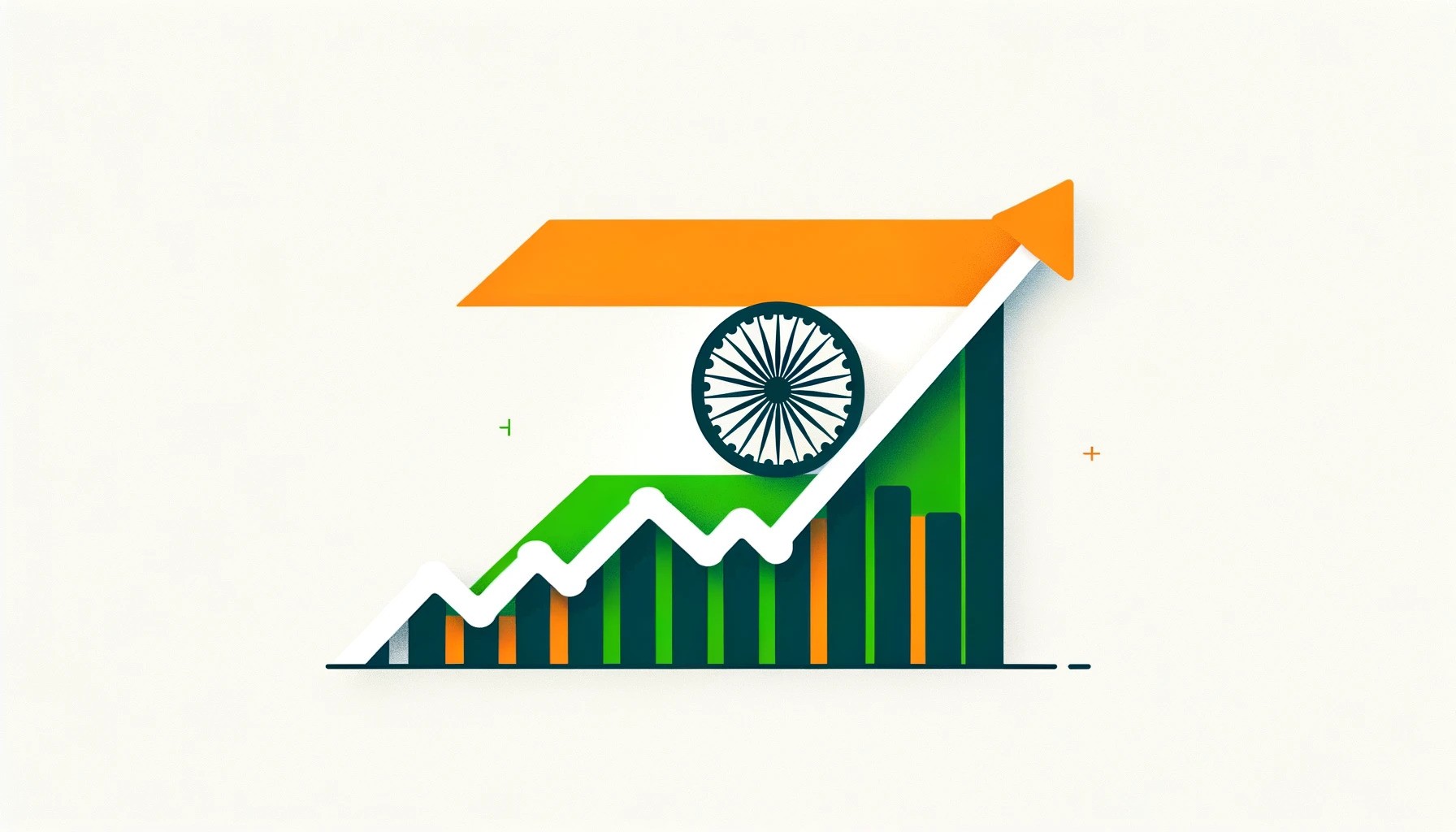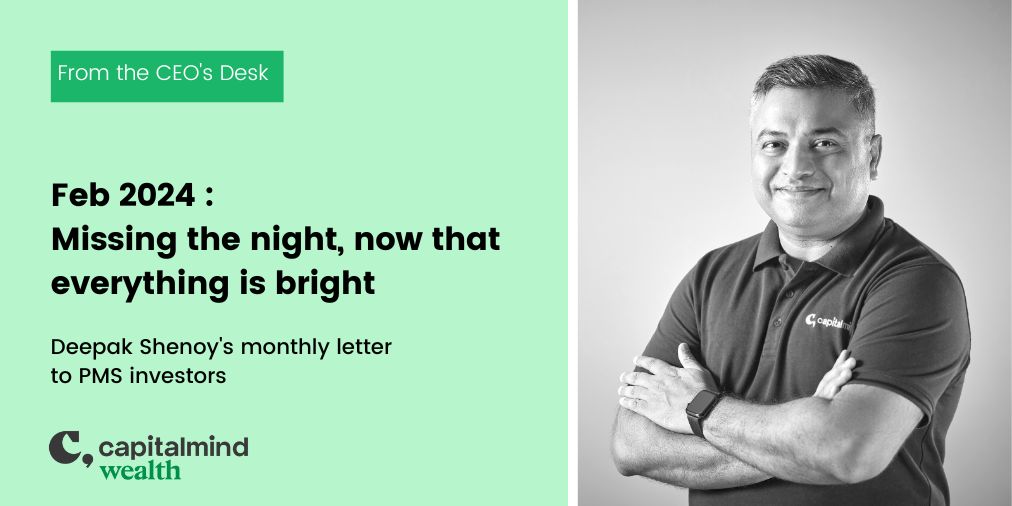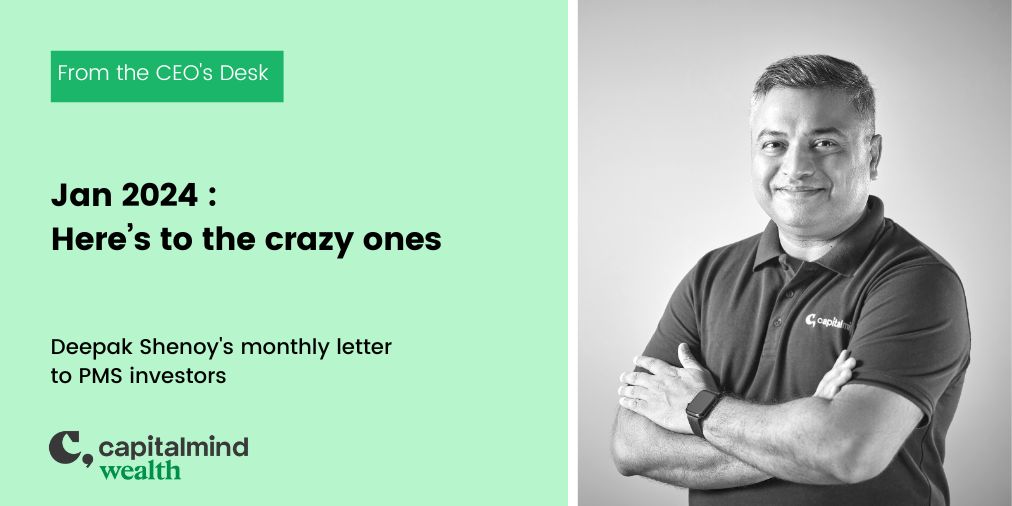[This is an excerpt from the Aug 2022 letter to Capitalmind PMS Clients]
It’s been a good month in July 2022, with the markets returning about 8% at the Nifty. Our active portfolio returns have been rough in the 1 year time frame, but above in the two and three year time frames.

The Index portfolio didn’t do quite as well as the Nasdaq underperformance continued in the year. In rupee terms, the Nasdaq is down 7% in the last year, compared to Nifty’s +10%.
It’s not useful for us to dwell too much on a one year outperformance or underperformance. The last year has not been good, we admit. It’s been particularly bad for the economy as well, with interest rates rising, the dollar hitting 80, crude going to $125 and what not. It isn’t surprising that there is craziness. It’s only surprising where the craziness comes from.
By many measures, the market is cheaper than it used to be. For example, the Price-to-equity ratio of the Nifty is now at around 21. That is not as high as we’ve seen recently (29-30 last year) so it seems reasonable. Now earnings too, have gone up – the Nifty earnings since March 31, 2022 has increased by 9.4% into August. To grow earnings by 9% in five months is quite something (there’s only been one quarter of earnings in the interim) This may be partly because last year, we had a Covid Wave 2 which was devastating. But it’s also because core earnings are up reasonably compared to even pre-covid times.
But is P/E the correct parameter to judge a market? Sure, if everything else was normal. But nothing seems to be normal.
So many strange things have happened that perhaps should have only happened once a century. We had an oil spike of mega proportions even as electric vehicles got more mainstream. Just two years ago, oil prices went negative (!) when the covid-lockdowns resulted in demand falling so quickly that markets couldn’t handle it. We’ve had a war in Ukraine, a massive rise in inflation all over the world, interest rate increases of the kind we haven’t seen in a decade. Germany is starting to use coal again. And yet, markets fell a little, shrugged it off and have behaved as if there’s nothing much that’s wrong.
The rule now is: Not everything impacts the markets. In fact, news that we are expecting hardly ever does. That’s why even when there is a Covid spike in many countries, we don’t care any more.
For example, on August 8, there were 78,000 new Covid cases in Germany. And 198,000 new cases in Japan. (In Japan!) There were 100,000+ cases in South Korea last week. And you don’t see the clamours for lock downs, or even any major changes in travel patterns. That’s because we’ve gotten used to this. Oh, some people will die, we say, but most will survive and that’s acceptable. Just one year ago, it was unthinkable that we would react this way.
But because we do, we behave irrationally. And markets, it follows, are not rational either, because they mimic our behaviour. This is why predicting markets is next to impossible: you can start with “all things being equal, this stock will be very successful”. And we focus on the second part of that sentence, looking so much more at the companies we own, and so on.
But it’s the first part that seems to drive so much more in terms of investment returns: that all else is not equal. Things change in the investment world constantly. The US Fed prints money like crazy, our stock prices do well, and we think it’s our skill in finding the stocks. The Fed threatens to stop printing money and markets crash like no one will even have food tomorrow. There are things beyond markets that determine investment returns that are hardly related to a company’s performance – sometimes it just has to be alive to thrive. A rising tide will lift all boats, even those with small holes in them.
This isn’t to undermine the hard work that great management puts in. Or that companies don’t have moats. In fact, you want a company that has a moat, a great management, solid cash flow, good unit economics etc. But you also need the tide to rise, for great portfolios to work.
What’s happening right now, it seems, is that the tide is rising. Ever so slowly. Showing up in stock prices, and in some earnings.There is altogether a lot of disdain for the macro in the search for investment rigour, but a healthy respect for the greater force is inevitable.
Having said that, what’s the scope for India to actually do well? We covered a lot in our July 2022 townhall (warning: 2 hours!) which basically says, for the short term:
- India’s inflation is cooling, while the west seems to still be seeing heavy inflation, especially Europe. Our recovery is likely to be faster.
- Even though foreign investors have sold 250,000 crores worth shares in the last 8 months, domestic investors and pension funds have bought nearly the same amount, balancing the outflows. Domestic participation is a strong trend.
- The government seems to be in better shape, doing very well on tax collections.
- Credit in the banking system has started to grow in double digits for the first time since 2019.
There are risks: A recession in the west that’s deep enough to hurt us. The war in Russia-Ukraine could expand a point where more countries are involved. Our nearest neighbours (Pak, SL, Bangladesh) are all in financial trouble, and some of that could hurt our recovery. And so on.
But most of these are shorter term in nature. We won’t remember most of them a few years from now. Like we don’t remember the fear about Brexit. Or that Greece would default, and the acronym PIIGS. The short-term fears or joys sometimes don’t last too long – what you want to check is longer term trends that will sustain, and where companies can take advantage.
There’s those we can see. ONDC and UPI will super-charge small-business logistics and credit. The dedicated freight corridor will reduce railway transportation times and costs to a fraction of what it takes today. The settling down of GST, the picking up of tiny scraps from a China+1 strategy, and the relative weakness of nearly all other large countries gives us a launching pad today that is almost as good as 1992. We will elaborate, in podcasts, videos and webinars – but the seeds of change are in, and the early shoots are visible.
Markets climb a wall of worry. The prices of stocks move before the businesses get to demonstrate their better potential. This isn’t just well known, it’s established worldwide too, in the presence of strong price trends that perplex investors who are looking for more valid reasons than “more people want to buy than sell”. When things look bad but the markets seem to be going up, it’s time to be humble and accept there’s probably something in there.
Momentum is now nearly fully deployed, and it doesn’t look like THAT much has changed fundamentally. This might be a “head fake”, but it might well be the beginning of a new market trend. Unfortunately we can’t give an expiry date to the bear market, or even an expiry month or year. At best, we’ll just say that there’s a better chance we might see markets go up compared to what we knew in May.
The danger of predictions and expectations: Anoop referenced the Hollywood thriller, Air Force One, where Harrison Ford played the US president. As Ford was making a dramatic mid-air transition using a cable from Air Force One (the president’s plane) to “Liberty 2-4” (another plane), a bunch of Americans in a closed room asked:
“Liberty 2-4, do you have the president”
(Pregnant pause)
From the plane: “Liberty 2-4 is changing call signs. Liberty 2-4 is now Air Force One”
(AF1 is any plane that the president is in)
It appears we’re in mid-air in our market. It’s impossible to predict, with any degree of certainty, what “will” happen. Anoop says it:
In January 2006, NASA launched “New Horizons”, the spacecraft meant to travel three billion miles to explore Pluto, the most distant celestial body in our solar system. It reached its destination nine-and-a-half years later in July 2015. And it did so within 72 seconds of the time they estimated in 2006—seventy-two seconds off after travelling three billion miles over nine and a half years.
Financial forecasts and models, open sourced or otherwise, with 137 input parameters, cash flow projections down to four decimals and a stock price estimate for 2026 might look deceptively similar to what went into the New Horizons estimate.
But ask yourself why Google Maps gets arrival times wrong on 20-minute road trips. Because there are people involved. People introduce uncertainty. And there are lots of those involved in determining outcomes for businesses; customers, suppliers, employees, competitors, regulators and more. And that’s before you even get to market participants.
If investing were like Physics, then the “best” investment strategy and investors who apply them would always outperform. It follows that there would be no reason for money to be invested in anything else. Ergo a set of stocks fitting that “best” strategy would go to infinity because buying them would always lead to superior results, conversely, everything else would go to zero because buying them would always lead to inferior returns.
You would argue, “Aha, what if only some folks knew that best strategy?”. But then, over time, it would become apparent that “here’s a strategy that always outperforms”, which would attract all available capital resulting in the closest thing to an infinity-zero outcome for the stocks involved.
If no “best” investing strategies exist, logically, any investing strategy will inevitably trail the index for periods. Whether it’s value stocks that trailed for 10+ years, quality businesses, turnaround stories, or industry disruptors. Any time your chosen investment strategy trails the index, it could mean one of two things; it’ll continue doing so because it wasn’t a very good investment philosophy, to begin with, and you should exit, or it’ll eventually come back and do better for you than the index.
I’ll leave you with this: The opposite of things that will change the world, will change the world.
What changes the game does so in ways that are invisible because we focus only on today’s leaders. It wasn’t evident that Jio would make India a super-consumer of data services. It wasn’t evident that UPI would hit 10 lakh crores in month transactions, leaving behind a 1 lakh crore in credit cards all over the country. It wasn’t evident that Amazon would be the world’s leader in remote computing.
If you asked someone in 2012: Who’ll change telecom? The answer would have been Bharti Airtel. In 2005: “Who’ll be the go-to place for building applications?” – Akamai, Microsoft or such. Who’ll be the biggest player in bank-to-bank retail transfers? – HDFC Bank.
How does Google and Walmart win in interbank transfers? How does an Amazon win cloud applications? How did an oil refiner like Reliance win telecom in India?
None of these was right. Because each of these original answers is a great company, with a solid track record. And yet, someone else seems to have won as of today. When we look at data of the past, and expect that those companies will win, we might want to say that any valuation is worth it, no matter how high. The bigger point, however, is to be able to change course when you’re wrong, to have strong opinions but to be willing to switch, and to live by the adage that a person I deeply respect, Joy Bhattacharjya, told me once:
Angels can fly because they take themselves lightly.
We believe strongly that the long term growth prospects for the Indian economy have improved, both as a domestic led consumption economy, and as a potential co-provider of goods and services for the world. Where this will really happen, we’ll have to wait and see, but there’s a great future ahead for all of us.
Opinionatedly,
Deepak
Connect with us!
Capitalmind Wealth PMS is India’s lowest-cost Portfolio Management Service for investors who deploy INR 50 Lakhs and more.
You can see more about our strategies at capitalmindwealth.com and their performance here.
Connect with us on @capitalmind_in or schedule a call with us by filling out this form




